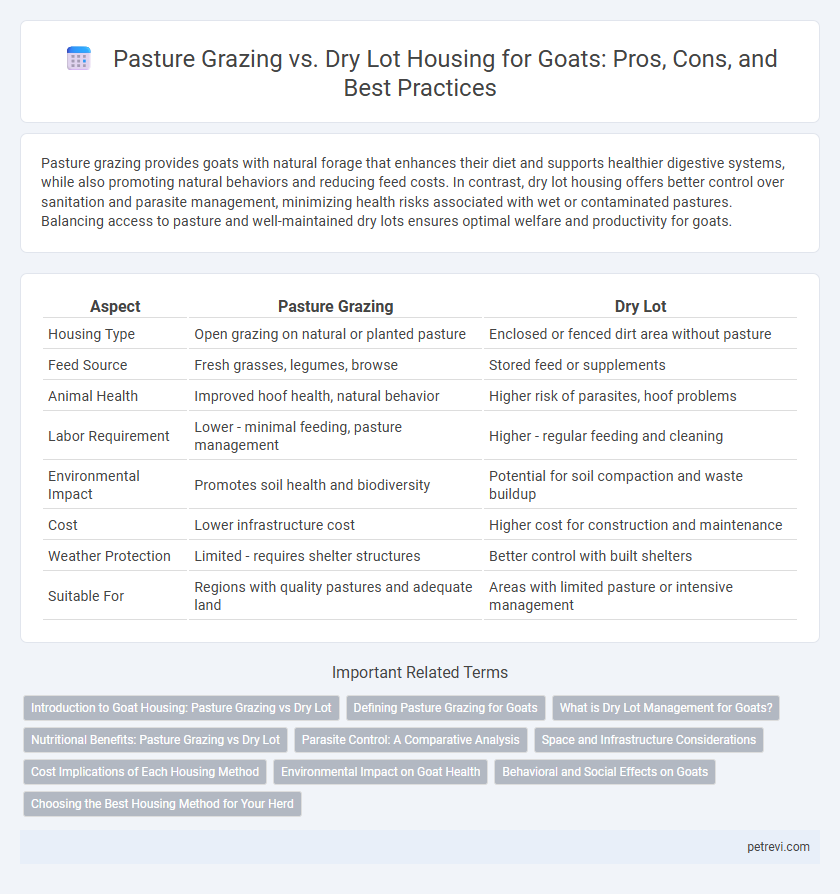Pasture grazing provides goats with natural forage that enhances their diet and supports healthier digestive systems, while also promoting natural behaviors and reducing feed costs. In contrast, dry lot housing offers better control over sanitation and parasite management, minimizing health risks associated with wet or contaminated pastures. Balancing access to pasture and well-maintained dry lots ensures optimal welfare and productivity for goats.
Table of Comparison
| Aspect | Pasture Grazing | Dry Lot |
|---|---|---|
| Housing Type | Open grazing on natural or planted pasture | Enclosed or fenced dirt area without pasture |
| Feed Source | Fresh grasses, legumes, browse | Stored feed or supplements |
| Animal Health | Improved hoof health, natural behavior | Higher risk of parasites, hoof problems |
| Labor Requirement | Lower - minimal feeding, pasture management | Higher - regular feeding and cleaning |
| Environmental Impact | Promotes soil health and biodiversity | Potential for soil compaction and waste buildup |
| Cost | Lower infrastructure cost | Higher cost for construction and maintenance |
| Weather Protection | Limited - requires shelter structures | Better control with built shelters |
| Suitable For | Regions with quality pastures and adequate land | Areas with limited pasture or intensive management |
Introduction to Goat Housing: Pasture Grazing vs Dry Lot
Pasture grazing offers goats access to natural forage, promoting better nutrition and exercise while supporting natural behaviors. Dry lot housing provides a controlled environment, reducing parasite risks and enabling easier management of feeding and health care. Balancing pasture grazing and dry lot systems can optimize goat welfare and productivity by leveraging the benefits of both housing methods.
Defining Pasture Grazing for Goats
Pasture grazing for goats involves allowing them to roam and feed on natural vegetation such as grasses, shrubs, and herbs in designated grazing areas. This method supports natural foraging behavior, providing goats with a diverse diet rich in nutrients and promoting their overall health and well-being. Effective pasture management includes rotational grazing to prevent overgrazing and maintain healthy pasture ecosystems suitable for sustainable goat housing.
What is Dry Lot Management for Goats?
Dry lot management for goats involves housing and feeding them in a confined, non-pasture area where natural grazing is limited or unavailable. This method allows precise control over nutrition, health monitoring, and prevents overgrazing and parasite buildup common in pasture systems. Optimal dry lot management requires regular manure removal, balanced supplemental feeding, and adequate shelter to ensure goat welfare and productivity.
Nutritional Benefits: Pasture Grazing vs Dry Lot
Pasture grazing provides goats with access to a diverse range of fresh forage rich in essential nutrients, vitamins, and minerals that enhance their overall health and immune function. In contrast, dry lot housing often relies on stored or supplemental feeds, which may lack the natural variety and fiber content critical for optimal digestion and nutrient absorption. Nutritional benefits from pasture grazing contribute to improved weight gain, milk production, and reproductive performance compared to goats kept in dry lots.
Parasite Control: A Comparative Analysis
Pasture grazing allows goats to naturally browse diverse vegetation, reducing parasite load through environmental exposure and pasture rotation, while dry lot housing confines goats, increasing parasite concentration if sanitation is inadequate. Regular manure removal and proper bedding management in dry lots minimize parasite eggs and larvae accumulation, enhancing overall health. Strategic pasture rest periods and mixed-species grazing further disrupt parasite life cycles, making pasture systems more effective for long-term parasite control.
Space and Infrastructure Considerations
Pasture grazing offers goats ample natural space promoting exercise and diverse foraging, reducing feed costs and encouraging natural behaviors. Dry lot housing requires well-designed infrastructure like sturdy fencing, shelter for weather protection, and proper drainage to prevent mud and hoof problems. Space in dry lots must be carefully managed to avoid overcrowding, ensuring goats have enough room to minimize stress and maintain herd health.
Cost Implications of Each Housing Method
Pasture grazing offers lower upfront costs by eliminating the need for extensive shelter construction and reducing feed expenses through natural forage availability. Dry lot housing requires significant investment in infrastructure such as fencing, shade structures, and daily feed supplies, increasing operational costs. Veterinary expenses may rise in dry lots due to higher risks of disease from confined conditions, whereas pasture grazing promotes natural exercise and reduces such risks, potentially lowering health-related costs.
Environmental Impact on Goat Health
Pasture grazing provides goats with natural forage, promoting better digestive health and reducing the risk of illnesses associated with confined spaces. Dry lot housing limits exposure to parasites and soil-borne pathogens but may increase stress and respiratory issues due to confined air quality. Balancing pasture access with controlled dry lot conditions optimizes environmental impacts while supporting overall goat well-being.
Behavioral and Social Effects on Goats
Pasture grazing allows goats to exhibit natural foraging behaviors and promotes social interaction within the herd, enhancing their mental stimulation and reducing stress levels. In contrast, dry lot housing restricts movement and limits natural behaviors, potentially leading to increased aggression and boredom among goats. Access to pasture supports healthier behavioral patterns and stronger social bonds critical for overall well-being in goats.
Choosing the Best Housing Method for Your Herd
Pasture grazing provides goats with natural forage, promoting better digestive health and reducing feed costs by allowing access to diverse grasses and plants. Dry lot housing offers controlled environments that protect goats from harsh weather, prevent parasitic infections, and facilitate easier monitoring and management of the herd. Selecting the best housing method depends on factors such as climate, available land, herd size, and resource management to ensure optimal welfare and productivity.
Pasture Grazing vs Dry Lot for Goat Housing Infographic

 petrevi.com
petrevi.com